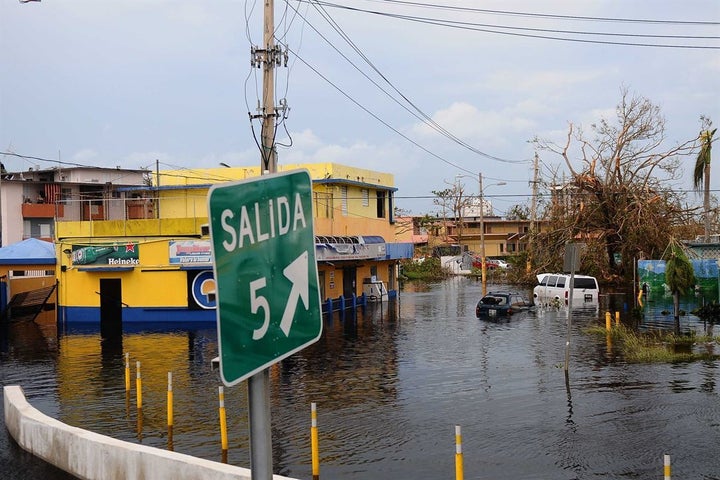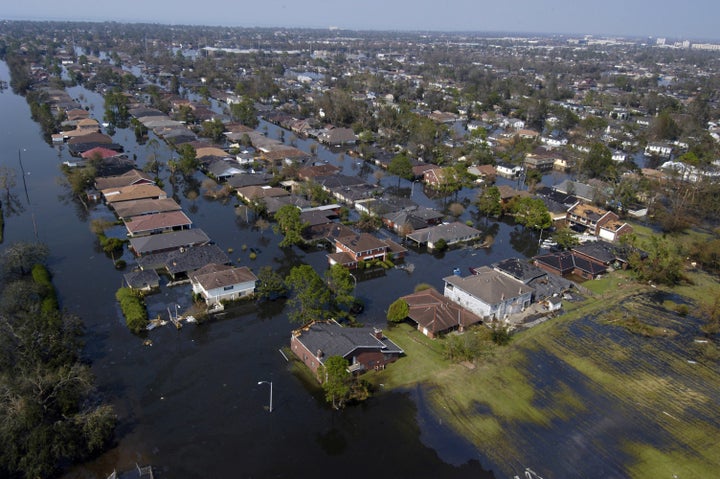
Puerto Rican residents walk in flooded streets in Condado, San Juan, Puerto Rico, Sept. 22, 2017, following Hurricane Maria. Source: Puerto Rico National Guard. Photo by Sgt. Jose Ahiram Diaz-Ramos.
This hurricane season Harvey, Irma, and Maria pummeled through the Atlantic and devastated all areas in its wake, including Texas, Florida, and Puerto Rico. What happens next determines whether people in post-hurricane regions will experience vulnerabilities that increase the likelihood for human trafficking such as migration, a flux in population, a fractured local infrastructure, crippled law enforcement, and un- or under-monitoring of temporary worker visas during the rebuilding process.
Hurricane Irma slammed Florida on September 10th, but even those areas most damaged, like Key West, are experiencing a fast recovery. In fact, Key West was back open for businesses by October 1st, less than a month after getting hit. Stringent building codes helped the city, with new buildings having minimal damage because they featured metal instead of shingle roofs. In other areas, such as Big Pine Key, the recovery has not been as rapid. Fallen phone and power lines continue to leave some residents without electricity. That said, the devastation in Irma’s wake was simply not outside the scope Florida was prepared for and previously experienced. Unlike the damage to Texas and Puerto Rico on account of Hurricanes Harvey and Irma.
Hurricane Harvey dumped more 27 trillion gallons of water on Texas, so much so that experts called it a once-in-1,000-years flood. It caused devastating damage in its wake, destroying homes and upheaving people’s lives. It seemed it could not get worse for the United States until, when, nearly a month later, Hurricane Maria passed directly over an already Irma-impacted Puerto Rico. “It was as if a 50- to 60-mile-wide tornado raged across Puerto Rico, like a buzz saw,” Jeff Weber, a meteorologist with the University Corporation for Atmospheric Research in Boulder, Colorado, told Vox. The storm not only cut down whatever was in its way, but also, in some parts, dumped more than 30 inches of rain.
Puerto Rico is experiencing what officials are calling “apocalyptic” conditions and a humanitarian disaster. More than half of the island is still without drinking water, and hospitals, now running on generators, are running out of fuel. The island is mostly without power and communication, leaving residents searching along primary roadways for a cellphone signal. Roads were washed away, broken, or blocked by debris. Governor Ricardo Rosselló said the U.S. government must help the 3.4 million citizens or risk a mass exodus from the island to the U.S. mainland.
Further causing devastation to the U.S. Commonwealth is the failing Guajataca dam, a “high hazard potential” dam pouring water into nearby areas and triggered an evacuation of thousands of people already devastated by Maria. The U.S. Army Corps of Engineers (USACE) defines the high hazard potential classification to dams where “failure or misoperation will probably cause loss of life.”
Government Response in the Aftermath of Hurricane Katrina
This story, unfortunately, is not unfamiliar to those who lived through Hurricane Katrina in 2005. In New Orleans, for example, the storm and failed levees destroyed buildings, ravaged the city’s infrastructure, displaced 600,000 households, and resulted in 986 deaths. Nearly half of all victims were elderly, and the primary causes of death were drowning (40%), injury and trauma (25%), and heart conditions (11%).
While a natural disaster is certainly not caused by any government, what is in a government’s hands is preparedness and responsiveness. Officials, including then-President George W. Bush, highly criticized the Federal Emergency Management Agency (FEMA) for its delayed response. The former president called it, “not acceptable.” Former Senator Joseph Lieberman of Connecticut said the government’s failure to prepare for and respond to the storm “allowed much more human suffering and property destruction to occur than should have...”
Richard L. Skinner, then-Inspector General at the Department of Homeland Security (DHS), wrote a 218-page report in 2006 noting that much of the criticism FEMA received for its slow and ineffective response to Hurricane Katrina was warranted. The report goes on to highlight that DHS’s prevention and preparedness for terrorism “have overshadowed that for natural hazards, both in perception and in application.”
Although an “all-hazards” approach can address preparedness needs common to both man-made and natural events, DHS must ensure that all four phases of emergency management – preparedness, response, recovery, and mitigation – are managed throughout the department on an all-hazards basis.
After Hurricane Katrina, FEMA’s shortcomings included timeliness, housing for displaced people, insufficient personnel for search and rescue, not testing programs before use, and insufficient tracking of supply fulfillment.
Government Response to Hurricane’s Harvey, Irma, and Maria
Florida is already on its way to recovery post-Irma, and, according to Forbes, Texas has an economy that is only second to California. The magazine also ranked the “Lone Star State” first in economic climate thanks to rapid economic growth over the past five years. Texas has experienced vast devastation, but it also has the infrastructure to accommodate the needs of residents in damaged areas. For instance, Governor Greg Abbott set up a commission that includes every state government branch. Furthermore, he assigned each mayor in the state an individual liaison to ensure efficiency. Not only do Florida and Texas have a strong infrastructure to help them recover, but they also immediately received adequate aid from the U.S. government.
So far, the U.S. government responsiveness has been vastly different for Texas and Florida than Puerto Rico. Before Hurricane Harvey even made landfall, FEMA had supplies and personnel ready to go in Texas. In the days immediately after, there was 31,000 personnel from FEMA, other federal agencies, and the National Guard. Even more federal personnel, 40,000, were in Florida within four days of hurricane Irma. FEMA also quickly supplied Harvey survivors in Texas with 3 million meals and 3 million liters of water and equipped people in Southeast states impacted by Irma with 6.6 million meals and 4.7 million liters of water.
The responsiveness to the third hurricane, Maria, in Puerto Rico has not been as rapid. It is unclear how many personnel were on the ground in the days immediately following the storm. FEMA said more than 10,000 personnel were in Puerto Rico and the U.S. Virgin Islands on Monday, September 25th, five days after the storm. The next day the agency said there were “thousands” of federal staff, including 500 FEMA personnel. By September 30, 2017, ten days after Maria directly hit Puerto Rico, President Donald Trump and Vice President Mike Pence said there were 10,000 federal workers on the island plus 4,500 National Guard, far less than the 31,000 and 40,000 sent to Texas and Florida.
On day seven after the storm made landfall, Brock Long, administrator of FEMA, said the U.S. government provided 4 million meals and 6 million liters of water, which is somewhat on par with what it sent Southeast states (2.6 million less meals but 1.3 million more liters of water), but it took a bit longer. Unlike for Texas and Florida, the U.S. government did not initially waive the Jones Act for Puerto Rico, which limits shipping to exclusively U.S. made, owned, and run vessels. President Trump said on Wednesday, September 27th that a lot of people in the U.S. shipping industry did not want the act temporarily lifted. On Thursday, at the request of Governor Ricardo Rosselló, the president waived the act for a 10-day period. Senator John McCain, Arizona, said the risk of not waiving the act is that it would force people in Puerto Rico to pay “at least twice as much for food, clean drinking water, supplies and infrastructure….” Carmen Yulín Cruz, the mayor of San Juan, said that waiving the act allows “… Puerto Ricans to rebuild and to have a cost of living that really frankly is affordable.”

Flood waters remain high in Carolina, Puerto Rico, Sept. 22, 2017, after Hurricane Maria slammed the island. Puerto Rico National Guard. Photo by Sgt. Jose Ahiram Diaz-Ramos.
Human Trafficking and Rebuilding after Hurricane Katrina
It is unclear what Puerto Rico, Texas, or Florida will experience in the next few months regarding rebuilding demands, but it is clear that both Texas and Puerto Rico have much rebuilding to do. Most at risk is Puerto Rico, which is not only more isolated by geography but also has a decrepit infrastructure that was not just damaged by Maria’s direct hit but also from Irma before it. Irma knocked out the electricity for more than one million residents; 70,000 were still without power when the second hurricane hit. The two hurricanes also decimated the island’s crops, roughly $780 million in agricultural yields. Furthermore, the island has been experiencing a long-standing financial crisis, making it even more vulnerable and in dire need of immediate and adequate aid at each step of the recovery process.
After Hurricane Katrina, the vast damage throughout the Gulf Coast meant affected areas had a high and sudden demand for low-cost labor for rebuilding, all of which took place in areas with fractured infrastructures and overextended law enforcement. To speed along recovery—whether it did is unclear—the U.S. government committed to temporarily suspending numerous employee protections in the Gulf Coast region. Including job safety and health standards, the Davis-Bacon Act wage restrictions, and the requirement that employers confirm employee identity and eligibility. The combination created the perfect storm for exploitation and human trafficking of migrant workers including H-2A, H-1B, and H-2B visa holders. While the Department of Labor (DOL) did not officially suspend investigations, it decreased the number of investigations in New Orleans from 70 the year before Katrina to 33 the year after. As Senator Dennis Kucinich highlighted, there was no “… federal cop on the workplace safety, wages, and hours beat.”
While the government didn’t directly encourage human trafficking, the recipe of suspended worker protections, decreased investigations by the DOL, and an under monitored H-2B guest worker visa program created an opportunity for unscrupulous people to exploit and traffic workers. In the Gulf Coast, traffickers forced people to live and work in labor camps or dilapidated buildings with armed guards to prevent escape. To survive, some caught and cooked pigeons in contaminated water while others saw suicide as their only escape. At least nine large cases, involving more than 3,750 victims, have been documented that may be classifiable as human trafficking. One case settled in 2008 while in other cases victims won civil suits against their traffickers between 2007 and 2015. It is often a lengthy and slow process.
One case is that of Thai workers brought into the U.S. under agricultural visas, but instead, traffickers forced the victims to perform demolition on moldy, debris-filled hurricane-damaged buildings. The recruiter, Million Express Manpower (MEM), falsely promised Thai workers legal visas, three years of employment, and $8.24 per hour. To secure their positions, each worker had to pay MEM $11,000. That meant workers had to take loans against their land and that of family members. This immediately placed the workers in debt, which MEM used as a selling point to U.S. companies looking for workers.
“Via word of mouth, [Million Express] Manpower, Inc., began to pitch its labor force as more inclined to work hard because they were so far in debt,” said attorney Lori J. Johnson, Managing Attorney at Legal Aid of North Carolina, Farmworker Unit.
Once in the U.S., the traffickers’ armed guards confiscated the victims’ return tickets, visas, and passports. After working for a month on a farm in North Carolina, the traffickers then took the workers to New Orleans to perform demolition. They had the victims live in the building they were demolishing, without running water or electricity. They did not pay nor feed the victims and an armed guard ensured they would not escape. In desperation, the victims caught pigeons and cooked them in contaminated water just to survive. They won a default judgment against MEM in 2009, though years later they have still not received actual money damages.
Another case is that of more than 360 Filipino teachers hired by the Louisiana Recovery School District after hurricane Katrina. Universal Placement International (UPI) recruited teachers from June 2007 to August 2009 and brought them to Louisiana under the H-1B visa. Each teacher had to pay recruiters a fee of $16,000 to secure jobs and arrange high-rent housing. Additionally, recruiters confiscated teachers’ passports and visas until the victims repaid their alleged debts; they also charged 10 percent of the teachers’ salaries in their second teaching year and threatened to deport them if they did not comply. In 2012, a federal jury ordered UPI to pay the teachers $4.5 million. However, jurors rejected the claim that UPI trafficked the teachers, finding that they willingly incurred the debt.
What the jurors failed to understand is traffickers use a false creation of debt as psychological coercion. These false debts, some as high as $40,000, place victims in debt bondage, a form of human trafficking. To pay fees, people have to sell their property and take out loans with astronomical interest rates. In cases where employers pay the cost, they tell workers they will have to work to pay off fees. Meaning, victims won’t see a penny of their earnings as wages allegedly go to conveniently continually incurring debts, including high-costs for housing and even work tools. FBI Special Agent Tom Simon said that “in the old, they used to keep slaves in place using chains and whips. These days, it’s done through economic intimidation.”

New Orleans (Sept. 2, 2005) - Four days after Hurricane Katrina made landfall on the Gulf Coast, many parts of New Orleans remain flooded. The Navy's involvement in the humanitarian assistance operations is led by the Federal Emergency Management Agency (FEMA), in conjunction with the Department of Defense. U.S. Navy photo by Gary Nichols.
Vulnerability to Human Trafficking Exacerbated by Displacement
After Hurricane Katrina, the Gulf Coast region became an ideal destination for human trafficking, and all identified forced labor victims were from other nations. This is not always the case. When people have lost their houses and communities to a natural disaster, they may attempt to find temporary housing within their community or are forced to migrate to places with greater resources and opportunity, and that can happen within a country or from one to another.
Puerto Ricans are U.S. citizens and thereby, much like New Orleanians, may leave the storm-ravaged area and go elsewhere. In fact, Central Florida is bracing for an influx of people from Puerto Rico, which officials estimate will be somewhere between tens of thousands to 100,000. In 2005, Hurricane Katrina displaced more than 400,000 people in New Orleans. In the years after the storm, the city’s population has incrementally increased to 391,495 in 2016, but still, some, particularly low-income, Black residents, have not come back.
Each year thousands of people in India are killed and displaced by monsoon rains. Survivors experience a complete life upheaval that makes them vulnerable to traffickers. Many of the displaced seek refuge in whatever structures remain such as government buildings, schools, community halls, or relief camps. Traffickers target these locations, often preying on the most defenseless population—i.e., children separated from their families by the monsoon. They also approach parents desperate to give their children better lives even if it means handing their children to strangers. People in India face similar struggles during droughts, where farmers are bankrupt and desperate for loans to get them through another cropless season. In both cases, the traffickers go to them.
In Haiti, residents internally displaced by Hurricane Matthew last year and the 2010 earthquake are among the most vulnerable populations to human trafficking. Roughly 1.4 million people lost their homes after the hurricane, forcing many to migrate to other areas, including the capital, Port-au-Prince, for food and shelter. Anthony Ngororano, head of U.N. Women in Haiti, said migration makes women and children particularly vulnerable to human trafficking. Women and girls are often at risk of sexual violence in temporary shelters and camps. “Trafficking and sexual exploitation of women and girls is all too much of a reality. This is accentuated by crises like these,” he told Reuters. Children of poorer families in Haiti are at similar risk to those in India after the floods or droughts; they are vulnerable to sex trafficking and forced labor (i.e., domestic servitude).
UNICEF said one tool essential to preventing human trafficking of children is reuniting them with relatives and rebuilding storm-ravaged schools. Another way to protect vulnerable populations, said Oxfam while aiding Haiti after Hurricane Irma, is for nations to tackle causes of extreme poverty “as part of their national strategies for disaster risk reduction.” The idea is that by investing in building up people's resilience, they will recover faster. Ngororano said after a natural disaster one way to minimize the risk of human trafficking is to provide women with ways they can earn money locally and quickly. U.N. Women, for example, did so in Haiti after Hurricane Matthew by partnering with cash-for-work companies to hire women to assemble hygiene kits.
Right now, what is critical is the survival of people in areas ravaged by the recent hurricanes. Many in Puerto Rico are still without critical life-maintaining needs such as food, water, and adequate shelter, and human trafficking is likely the last concern on everyone’s minds. That said, displacement, population flux, poverty, fractured infrastructures, and un- or under- monitored rebuilding are all ingredients to increased vulnerability. Immediate and adequate government aid, as well as appropriate government monitoring throughout the rebuilding process, can help minimize vulnerability and the risk of exploitation and human trafficking.
This post was originally published on the National Association of State Mental Health Program Directors (NASMHPD) website.
